I spent last Thursday on a long field trip in the Valley and Ridge province of northernwestern Virginia. Leading the trip was Dan Doctor of the USGS-Reston. Accompanying Dan was a UVA environmental science student named Nathan. And the NOVA crew rounded it out: professor Ken Rasmussen from the Annandale campus, associate professor Victor Zabielski from the Alexandria campus, and me. We met at the Survey at 9am, and headed west towards Strasburg, site of my Massanutten field trip.
We started off by examining three Ordovician carbonate units (all above the Knox Unconformity) on the I-81 exit ramp at Route 11. This is the same sequence seen at the classic Tumbling Run outcrop: the New Market limestone, the Lincolnshire limestone, and the overlying Edinburg Formation. We looked at fossils, stratigraphy, some minor structures, and some interesting lithified gunk on the inside of some solution cavities (small caves). Dan interpreted it as collapse breccia: lithified sediment from inside the cave. The question was: when did it form? We wrestled with the best way to test its age, and didn’t come to any clear conclusions. I love moments like that one: out in the field, one geologist shows another something that’s caught his or her attention, and the other geologist reacts, and the two toy with the idea, batting it around like a cat with an unknown object. Like the cat, geologists will either then get really excited and attack the new idea, or get bored, shrug, and walk away.
Our next stop was Crystal Caverns, a commercial cave that is in ownership limbo. Our spirited guide Babs said that it was likely the last time she would lead a tour down in the cave. She was busy liquidating the artifacts of the adjacent Stonewall Jackson Museum, which had recently been shut down by its board of directors. The cave is accessed via a small building that has been built over its mouth. It was a cool cave with a significant 3D aspect: we descended in a corkscrew like fashion, then came back up via a different route. Very cool. A shame that it is being closed (at least temporarily) to the public.
We followed the cave with lunch at a local Mexican restaurant, and while we were there, a big thunderstorm rolled through. Victor, Dan, and I played dueling iPhones to get imagery of the weather front and plot out our plan for the rest of the afternoon.
The afternoon was spent visiting outcrops on the west side of the Great Valley, working our way up to Route 50, and then west to Gore, VA. I wasn’t especially fastidious about photographing everything we saw, but here’s a sample of where I opened the camera shutter…
Ooids in the Conococheague Formation:
Same shot, zoomed in to the middle:
Fossil (blastoid? crinoid?) stem, Needmore Formation:
There were some lovely Opuntia cactus blooming among the vetch at this Needmore outcrop:
From there, we checked out the Chaneysville Member of the Mahantango Formation, where we saw some snail fossils…
…and some spiriferid brachiopod fossils:
Our last stop of the day was at the Clearville Member of the Mahantango Formation, which had lots of lovely coral fossils in it:
Dan put together a Google Map of our 17 stops; if you’re interested in checking out some of these places yourself, then this is a great resource.
I’d like to publicly thank Dan for taking a work day to contribute to our understanding. It was a lot of fun!


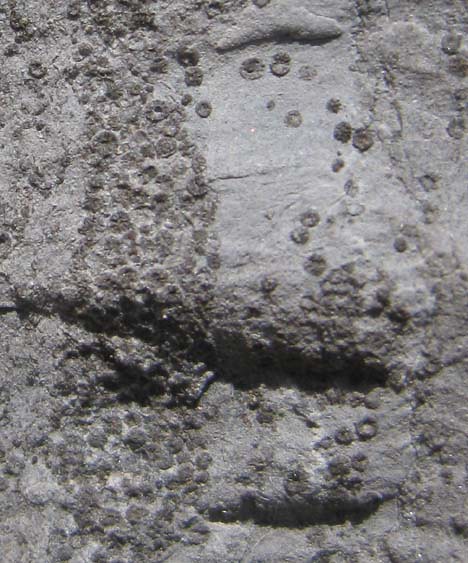
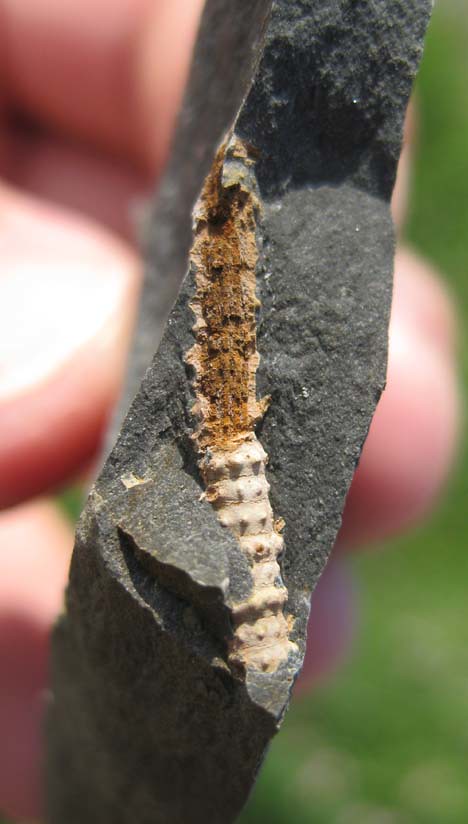
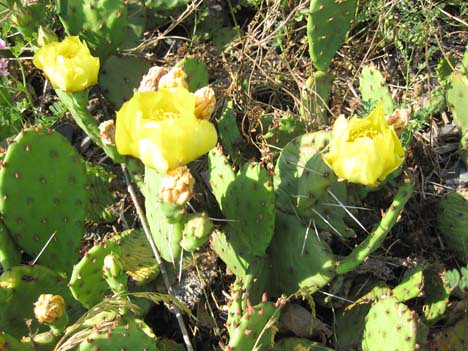

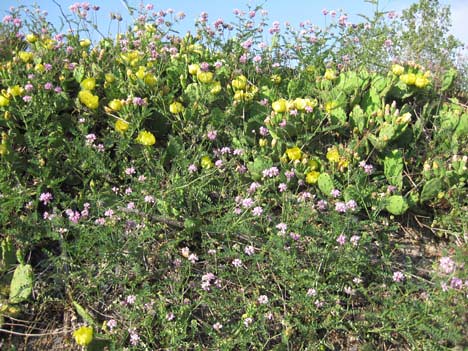
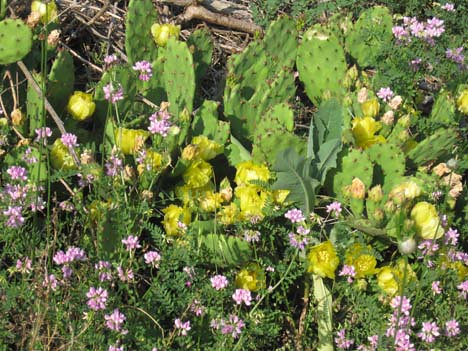


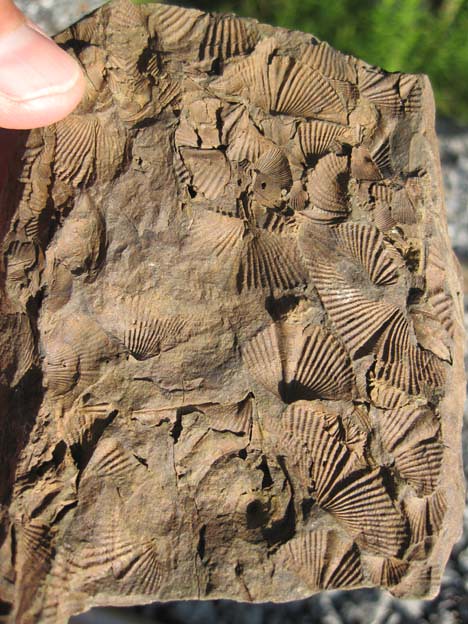
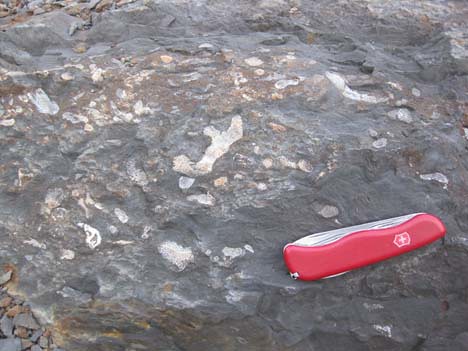
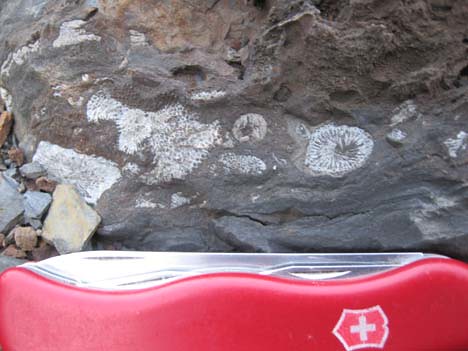
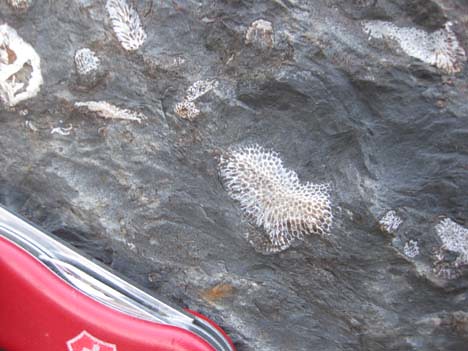
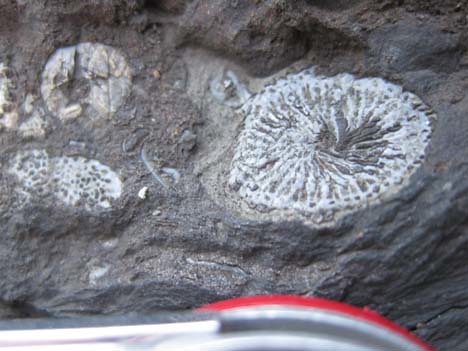
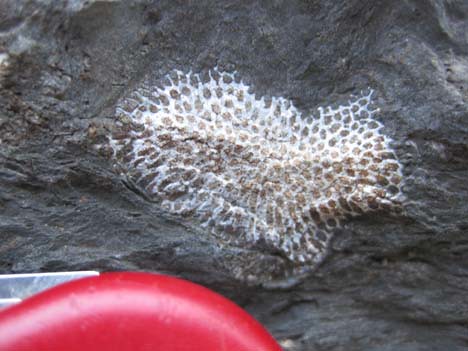
Some other Dan Doctor maps for the area:
Good stops in the Whitehall quadrangle
and
Road log of Frederick County (by W.E. Nunan, 1971, Virginia Minerals, Vol. 17, No. 2; additional stops added by D.H. Doctor, 2009)
Are some of those “guys” bryozoans? (man, it’s been awhile). Great photos, Callan, especially that crinoid stem. Amazing what detail you can see in that Needmore shale.
The last batch? No, they all appear to be corals.
Thanks for the kind comments!
C
I think that I remember a discussion here about a similar fossil last year??? The consensus then being coral. If they are coral, then they are tabulates(there doesn’t appear to be any septa)???
When I tried enlarging one of the photos that showed a longitudinal section, I didn’t discern any tabula.
What is the reasoning for coral and not bryozoan?
I’ll go with the second to last photo showing a rugose coral in the right center (a blow-up of the photo, 2 above this one), but I’m thinking like Solius Symbiosus that the others aren’t tabulates for the reason SS mentions. And I don’t recall any scleractinians “down here.” I’m still thinking bryzozoans – cyclostomes???
In the third to last photo, that is definitely a bryozoan in the upper left/top edge – longitudinal section.
I could be wrong -no doubt – because it’s been awhile and I ended up seeing more Miss. fenestrate forms than others in my rocks, but…
The Photo above the “blow-up” shows one that exhibits curvilinear zooecia longitudinally. For that reason it appears to be a trepostomate. Too, the cyclostomate/tubuliporate are generally encrusters.
@Mike and Solius Symbiosus: so glad to make a virtual acquaintance with you!
I’m terrible when it come to identifying fossils, so please let me know what you make of this one:
http://picasaweb.google.com/lh/photo/bhroSdM28PNH87Yg6pEpwfDqPNxnFmspEXix47qM_80?feat=directlink
Thanks, Callan, for posting!
I’m not sure, but I have a couple of ideas. What is the age and formation? Too, can you provide a high resolution pic?
Duh! I guess it is from the Mahantango???
Dave over at Views of the Mahantango collects that formation.
Perhaps, he will chime in.
@ Solius: Yes, it is within the very top of the Mahantango, the Clearville member, same locality as the corals in Callan’s photos.
I’m thinking that it is some kind of tabulate. Perhaps, a favositid of some kind, but I would like to see a higher resolution pic, or a photomicrograph of the two dissimilar regions. When I enlarge the photo, it quickly looses integrity.
The area to the right appears to be longitudinal sections. While those on the left appear to be orthogonal to the tubes???
Was it a clast that was washed in during a storm deposit?
@Doctor Dan: Interesting cross section of a Favositid coral in your link. I am hesitant to call it Favosites turbinatus because so little of the rest of the colony is exposed. I have a similar formation in the Mahantango up here in PA called the “Centerfield coral reef” and it corresponds to the Centerfield limestone of NY and Hungry Hollow fm. of Arkona, Ontario. While you can find turbinatus in the latter two formations, I’ve yet to see any from the Centerfield member in PA.
There are two papers that I’ve been meaning to get copies of that were published by the Pennsylvania Academy of Sciences in their proceedings: V31 pg91-97 and v45 pg5-8 that discuss the member better. Maybe you can get a copy for yourself through academic sources.
Hi Dave, good to see you posting on Callan’s blog.
When I was younger, I used to view any geologists, other that paleontologists, as slackers…. most of them avoided any paleo class like the plague! Perhaps, it was the paleo instructor at my institution; she was gruff, but damn! I learned a lot.
Can gruff be used to describe a woman???
Well, maybe not, but Dr. Lois Campbell ran the dept.-she owned all of them.
As you know, I am an older student. When I started back in the day, women had few places in the geological sciences… other than paleontology. Hence…
Anyway, It was Lois’ instistence that structural geology was the key to understanding anything with Laurentian fauna that led me to Nick Rast… one of the greatest structural geologists to ever publish… and perhaps, one of the most humble persons that I have ever met.
I shouldn’t share this but… once on a field trip through the Blue Ridge, we had camped at some god forsaken place.
Some of the students and instructors decided to forsake the campground, and instead, spend the night at the local motel.
Those of us that decided to stay at the campground; on a rainy night, decided to… well party. Hell! We are GLY students, after all.
Needless to say, I came prepared…. a couple of chickens and a 4/5 of 101.
Then some fool broke out a bottle of Valium.
I awoke in a mud puddle the next morning with the van beside me… and a few standing around…
Dr. Rast’s first’s comment was “I bet you had one hell of a night”.
Nick Rast-In my thoughts:
http://www.sciencedirect.com/science?_ob=ArticleURL&_udi=B6V9X-4C8D564-1&_user=10&_coverDate=07%2F31%2F2004&_rdoc=1&_fmt=high&_orig=search&_sort=d&_docanchor=&view=c&_searchStrId=1369165144&_rerunOrigin=google&_acct=C000050221&_version=1&_urlVersion=0&_userid=10&md5=777ba3ec4588c3e280157d06c53896b8
I should add: If you didn’t know Dr. Rast, his accent was intimidating.
At least is was to me, an ignorant Kentucky redneck!
Great stories! Sounds sort of like our “New Grad Student Field Trip” at VPI in 1978, minus the pharmaceuticals and rain.
Also, to Dr. Dan – Great Devonian photos. I’ll go with what SS and Dave said. Neat specimen.
Oh, and I should add, “Nice blogs, you guys.”